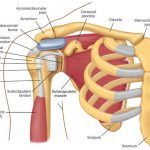When you hear the phrase “shoulder pain,” chances are you or someone you know can relate. Shoulder pain can result from a variety of injuries and conditions, typically accompanied by restricted motion and painful inflammation.
The shoulder is essentially a massive “joint” on the body where bones meet and are connected by ligaments, tendons, and muscles. Where the upper arm bone (humerus) fits into the socket of the shoulder blade (scapula), you form the shoulder with the collar bone and acromion bones meeting to rest above it, and a bony hook protruding off the shoulder blade, called the coracoid process, helping keep everything in place.
The connective tissues including the rotator cuff, a group of small muscles and tendons that surround the shoulder, the bursa sac that cushions the rotator cuff, and the labrum, a cuff of cartilage that forms the ‘socket’ of the scapula, all protect and support the wide range of motion the shoulder has. Common shoulder injuries include:

- Osteoarthritis – painful inflammation of the shoulder joint
- Bursitis – swelling of the bursa sac between the acromion and rotator cuff causing pain
- Dislocation – partial or total dislocation of the upper arm bone out of the shoulder socket
- Frozen Shoulder – thickening and stiffening of the shoulder capsule limiting motion
- Shoulder Impingement – when the top of the shoulder blade presses down and pinches connective tissues
- Tendinitis – the wearing down and tearing of connective tendons, destabilizing the shoulder
- Fracture – impact breaks to any of the bones in the shoulder area
While some age-related wear and tear is natural, unfortunately, the shoulder is a rather loose joint that is more susceptible to injury than others. The good news? There are highly effective preventative measures you can take in day to day life, at work, and when training as an athlete to prevent shoulder pain and shoulder injuries. Check out these tope 5:
1) Avoid Bad Posture
Bad posture including slouching and slumping when sitting or standing places constant stress on the shoulder muscles and ligaments which tend to hunch forward when the back is rounded instead of straight. It additionally compresses the spine and strains connective muscles and tendons all the way down your back which work in conjunction with everything else. Inflamed lower back muscles could radiate into pain in your neck and shoulders. Good posture where shoulders fall down and back as your spine lengthens places the shoulders in their natural and most stable position, helping prevent injury and strain.
2) Learn Correct Training Techniques
So often with workouts, and especially lifting weights, people will discover shoulder pain simply from not employing the correct techniques. For example, lifting dumbbells away from your body like wings in a lateral raise can incur subacromial impingement if you lift them over 90 degrees. Stretching post-workout or after a lifting circuit is also vital to preventing shoulder injury and pain. After a workout, muscles are the warmest and most pliable. By stretching them, you re-lengthen muscles (which became shorter and tighter with your workout), helping to foster muscle growth and flexibility.
3) Don’t Overuse Your Shoulder
It always seems to be the major league pitchers who get the worst of the shoulder injuries, right? Simply put, overuse of the same repeated upward and around motion of the shoulder will result in painful degeneration. Tendons and muscles wear down, destabilizing the shoulder. Natural cushioning from the bursa sac becomes painfully inflamed, the rotator cuff starts to tear, and well, it’s not pretty. So you’re not a major league pitcher – your job or day to day life may call on repeated and forceful use of your shoulder. When possible, avoid overuse and stretch and strengthen the shoulder muscles to prevent injury.
4) Wear Supports & Braces
Just like you might employ a brace for knee pain or a thumb splint for hand pain, you can wear a rotator cuff support brace for your shoulder pain as well. Typically recommended during recovery or for playing with a previously injured shoulder, shoulder braces and rotator cuff braces help steady the shoulder joint to limit motion and provide compression to help reduce inflammation. This improves stability and eliminates a large amount of discomfort associated with shoulder injuries.
5) Rest
Obvious one, right? Not quite. Even the beginning of shoulder pain may seem mild or un-noteworthy, but, rest allows your body to address and repair damaged tissues before they limit activity altogether. Repeated motions like throwing a ball or swimming may induce shoulder pain, so switching to cross train with different exercise like riding a stationary bike or hiking can keep you moving while preventing further wear and tear. Continue with gentle stretching, however, to maintain shoulder motion and boost blood circulation to aid healing.
Naturally, if sneaking shoulder pain is preventing you for doing the activities you love, see your healthcare provider right away. They can address your concerns, formulate a diagnosis, and get you on a treatment plan for recovery.
Visit our shoulder and back support page for a complete listing and get moving again.